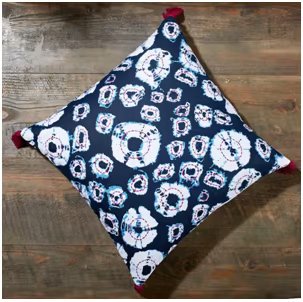
The Cultural Ties Of Shibori
Despite being inspired by the Japanese word ‘Shiboru’ which means to squeeze or press, there is much cultural debate regarding the true origin of Shibori technique of dyeing. This is a method which entails shape resistant dyeing of a fabric where some parts of the fabric are restrained, keeping the dye from permeating all over the cloth, resulting in intriguing and unique patterns.
Some say that Shibori dates back as early as the 8th century, when a Buddisht temple in Nara received a piece of Shibori dyed cloth as an offering from Japanese Emperor Shomu. The unique patterns caught the fancy of Buddhist monks who then started to learn and infuse Shibori tie and dye into their clothes too.


(L) Image via https://www.lookandlearn.com/ : An archival fragment of silk featuring Shibori Tie and Dye, (R) Image via: https://commons.wikimedia.org/ Technique of tying thread on fabric to achieve ‘Shibori’
However, other sources challenge the Japanese legitimacy of Shibori as remains of Shibori Silk have been unearthed from ancient tombs along the Silk Road, which date back at least 1500 years. Additionally, Shibori Dyed Wool which dates back to the previous millennium has also been recovered from South America.
Tie and Dye across the world
Regions across the world evidently took Tie and Dye and made it their own. In India, Ekdali and Trikunti are popular means of Bandhani Tie and Dye, with the names indicating the number of knots that are created to achieve the desired effect. Leheriya (meaning Ocean Waves)Tie and Dye is native to the Rajasthan region in India too.


(L): Image Via https://commons.wikimedia.org/ freshly dyed Ekdali Bandhani, (R): Image Via: https://ndla.no/ African Tie and Dye known for its trademark psychedelic aesthetic
On the other hand Mudmee is a Tie and Dye style from Thailand and Laos regions and much efforts are being made to preserve this unique art form. With only a few artisans knowing how to recreate it, Mudmee is considered an incredibly unique and exquisite form which results in beautiful patterns.
In American sub continents, African tie and dye is most extensively known, owing to its popularity in the 60’s and periodical resurgence thereafter.
Distinct Interpretations
Clearly, several cultures across the world have taken ‘Shibori’ or the art of shape resistant dyeing and made it their own in one way or another. These distinct styles of dyeing have their unique identifiers today. For example: Miura is a unique style of dyeing which entails pinching small sections of the fabric together and securing them with rubber bands to create diamond-like repeated patterns.


(L): Print Inspired by Miura Shibori Style, (R): Print inspired by Arashi Shibori Style. Images via: www.vliving.com
On the other hand Arashi ( meaning storm in Japanese) or pole wrapping Shibori is a style where fabric is diagonally wrapped around a pole and tied with thread to create a pleated or linear ripple like effect. Other Shibori Dyeing techniques include Kumo which involves use of pebbles, Nui that requires stitching to attain more complex patterns, Itajime for which wooden blocks are used to achieve symmetrical patterns and Kanoko which is the most simplistic style of restraining fabric with use of thread.
A Fresh Spin On A Celebrated Tradition
Shibori is traditionally known for its use of ‘Indigo’ Dye, an ode to the olden days when Indigo, Beetroot and Rose Madder were used to achieve hues of blue, red and purple. Much of the V Living Shibori collection has been created whilst preserving the identity of this art and our use of Indigo color for recreating Shibori in a print form is testament to that. On the contrary, shades such as black, red and yellow add a much needed juxtaposition with a contemporary flare.


(L) Apron and (R) Curtain from Shibori Collection by V Living
A collection of everyday essentials such as storage baskets, curtains, table runners and aprons superimposed with this historical art form lend home owners the choice to create a rich and eclectic space, where as decor items such as statement Shibori cushion covers draw the eye of onlookers, elevanting lounging spaces to inspiring nooks.


(L) Storage Pouch and (R) Store Basket from Shibori Collection by V Living
An extensive range and a celebrated art form come together to create a wholesome and tasteful collection of home essentials, created with love by V Living.
